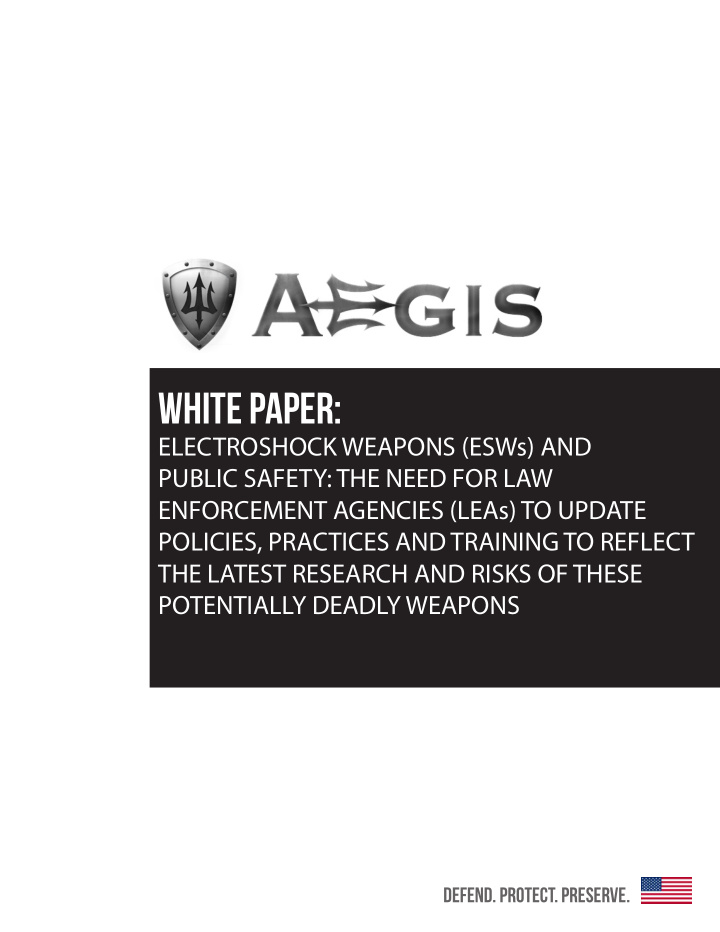



WHITE PAPER: ELECTROSHOCK WEAPONS (ESWs) AND PUBLIC SAFETY: THE NEED FOR LAW ENFORCEMENT AGENCIES (LEAs) TO UPDATE POLICIES, PRACTICES AND TRAINING TO REFLECT THE LATEST RESEARCH AND RISKS OF THESE POTENTIALLY DEADLY WEAPONS DEFEND. PROTECT. preSERVE.
AEGIS INDUSTRIES PROBLEM: Electroshock weapons (ESWs) are “non-lethal” weapons designed to introduce electrical insult into a human body for the purpose of creating pain and incapacitation. U.S. Government reports acknowledge that ESWs were developed anecdotally and not scienti fi cally. Due to the lack of any government standards for safety or oversight, high-power ESWs were introduced into law enforcement agencies (LEAs) in 1999 as “less lethal” options, without the scienti fi c scrutiny or operational performance standards required of less dangerous electronic technologies. The original claims of medical safety and “veri fi cation” of electrical safety made by manufacturers and other “independent” reviewers included statements that the electrical output could not a ff ect cardiac or respiratory functions. In fact, one author actually stated, “the Underwriters Laboratory (UL), and the International Electrotechnical Commission (IEC) have published studies that have found that these increases are well within the electrical output safety margin needed to prevent ventricular fi brillation.” These claims of medical and electrical safety responsible for the proliferation of ESWs throughout LEAs worldwide have proven to be false and misleading. Independent government researchers, leading electrophysiologists, cardiologists, and other medical professionals have since conducted research that clearly contradicts these original claims of safety. Manufacturers themselves have now withdrawn these earlier claims and acknowledge that ESWs can, in fact, capture cardiac rhythm, a ff ect respiration, and lead to death. The latest admissions, warnings, and disclosures by manufacturers regarding the “known and potential side e ff ects” of ESWs have left agencies, o ffi cers, and municipalities exposed to civil liability regarding the deployment of these potentially deadly weapons. While it is a simple e ff ort for manufacturers to issue revised training bulletins, modify warnings, and update disclosures that protect themselves from liability, it is a much more complex e ff ort for agencies and o ffi cers to modify their policies, practices, and training to re fl ect the latest research and risks regarding ESWs. The most challenging issue relative to the latest research and risks is to convince those o ffi cers whose training is based on outdated claims of safety that targeting and deployment of these popular weapons has radically changed and can now result in civil and criminal liability for themselves and others. [This individual] su ff ered “sudden cardiac death due to [ESW] discharge.” - Vermont State Police, September 2012 1
AEGIS INDUSTRIES SOLUTION: It is timely for LEAs to recognize the need to update all policies, practices, and training for ESWs to re fl ect the latest research and risks associated with these potentially deadly weapons. For years, law enforcement organizations, institutions, agencies, and o ffi cers have focused on the “management” of ESW technologies, but not on the technology itself. This needs to change. Law enforcement executives need to promote a paradigm shift regarding the true understanding of ESW risks throughout their agencies, organizations, and institutions. This paradigm shift needs to start with law enforcement leadership taking a comprehensive approach to understanding that ESWs policies, practices, and training were originally developed based upon inaccurate claims of safety that were not developed through a rigorous scienti fi c approach, nor an independent peer-reviewed process before being introduced, adopted, and deployed. Failure to do so can expose law enforcement executives and o ffi cers to accusations of deliberate ignorance and indi ff erence. Law enforcement executives should mandate an ESW Safety Stand Down Day to conduct safety training that will raise awareness and highlight the proper importance that should be placed upon these new policies, practices, and training. The agenda for this Safety Stand Down should list, analyze, and compare the original, inaccurate, and outdated claims of safety with the latest claims being made by manufacturers. This training should also include basic information about ESW output and the variability that has been found by certi fi ed and independent laboratories. O ffi cers need to be made aware that this technology was deployed with no independent formal review, no standards for safety, no standards for performance, and with no way to verify the electrical output discharged from these potentially deadly weapons. An ESW Safety Stand Down Day would also provide an excellent opportunity to introduce the need for measurement of ESWs utilizing an independent standardized measurement method to identify and limit weapon variability, increase o ffi cer and public safety by ensuring better reliability and operation. Measurement would also demonstrate to the public that LEAs are proactive, transparent, and accountable in deploying this potentially deadly technology. This training approach will provide agencies with an opportunity to not only discuss proposed updated policies, practices, and training with o ffi cers, but will also solicit insight and input for consideration into the development of these policies. This approach will demonstrate the serious consideration LEAs are giving the latest research and warnings, as well as provide o ffi cers with a better understanding of the risks associated with deploying ESW technology on vulnerable populations. Once o ffi cers truly understand that the electrical current delivered from these weapons to an individual is not constant, but is, in fact, variable according to the resistance of an individual and can increase as the duration of exposures increase, the warnings, especially regarding vulnerable populations, will have more signi fi cance and the paradigm shift will take place much more quickly. This training may also identify the appropriate method LEAs should use when introducing and adopting non- 2
Recommend
More recommend